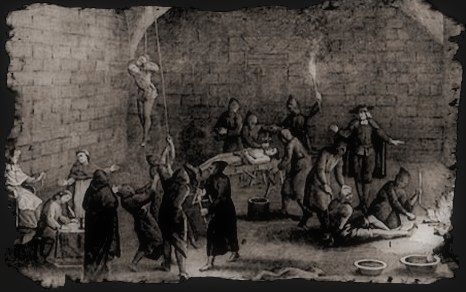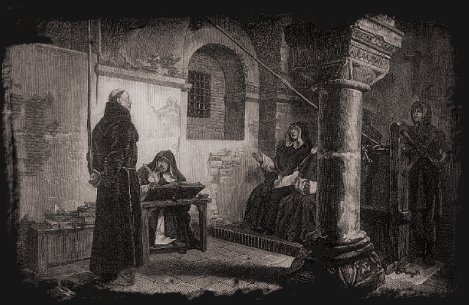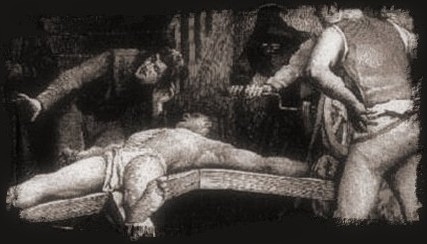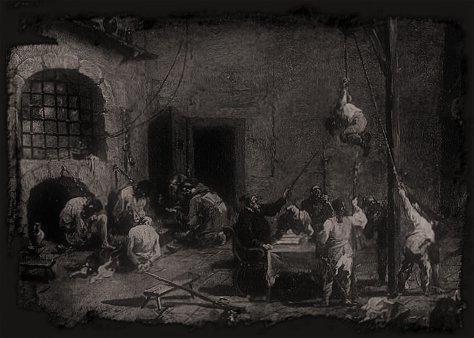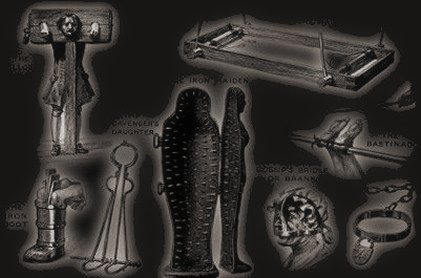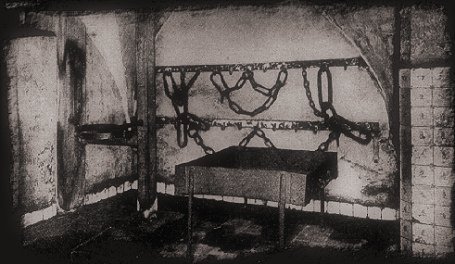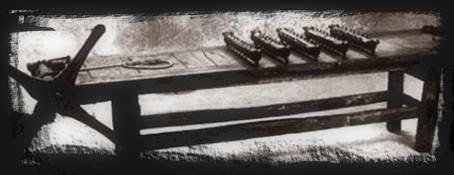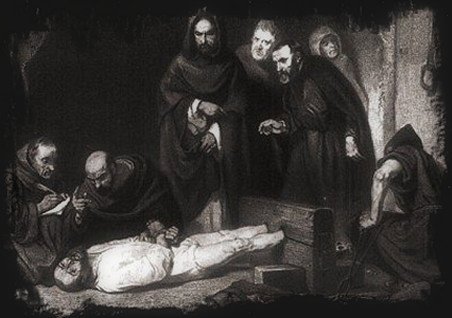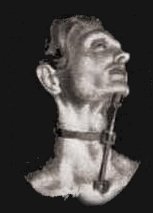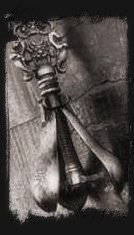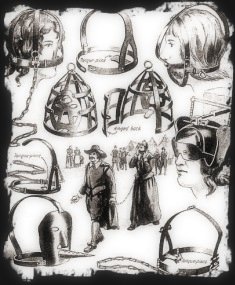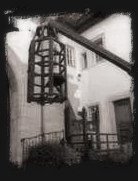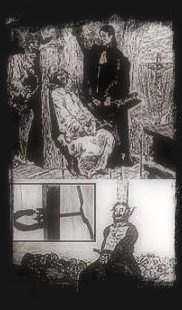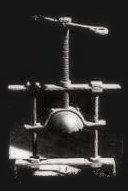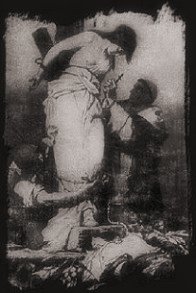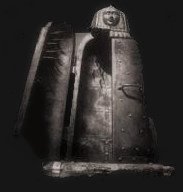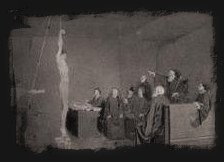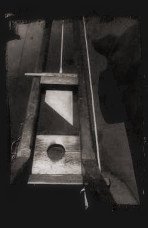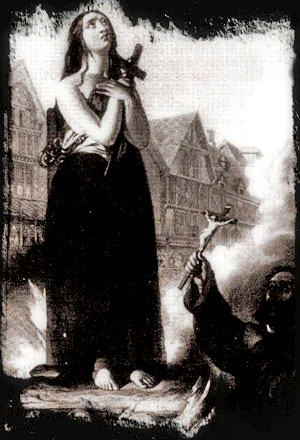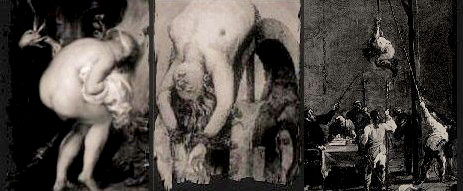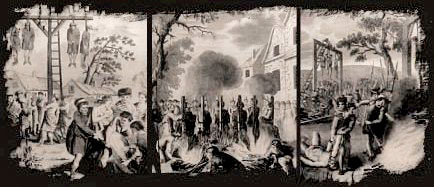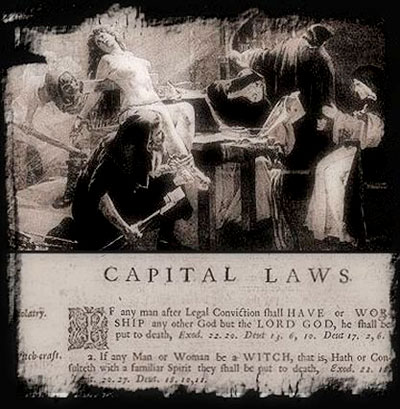|
from Christprise/"> TheChristianEnterprise Website
Christprise/holy-inquisitions.html"> The Church
The Inquisition was an ecclesiastical court and process of the
Roman
Catholic Church setup for the purpose towards the discovery and
punishment of heresy which wielded immense power and brutality in
medieval and early modern times. The Inquisitions function was
principally assembled to repress all heretics of rights, depriving
them of their estate and assets which became subject to the
ownership of the Catholic treasury, with each relentlessly sought to
destroy anyone who spoke, or even thought differently to the
Catholic Church. This system for close to over six centuries became
the legal framework throughout most of Europe that orchestrated one
of the most confound religious orders in the course of mankind.
All crimes and
all vices are contained in this one word Inquisition. Murder,
robbery, arson, outrage, torture, treachery, deceit, hypocrisy,
cupidity, holiness. No other word in all languages is
so hateful as this one that owes its abhorrent preeminence to its
association with the Roman Church.
After this period of grace had finished, the inhabitants were then summoned to appear before the Inquisitor. Citizens accused of heresy would be woken in the dead of night, ordered, if not gagged, and then escorted to the holy edifice, or Inquisition prison for closer examination.
In 1244, the Council of Harbonne ordered that in the sentencing of heretics, no husband should be spared because of his wife, nor wife because of her husband, and no parent spared from a helpless child. Once in custody victims waited before their judge anxiously, while he pondered through the document of their accusation. During the first examination, enough of their property was likewise confiscated to cover the expenses of the preliminary investigation.
The accused would then be implicated and asked incriminating and luring questions in a dexterous manner of trickery calculated to entangle most. Many manual's used and promulgated were by the grand inquisitor Bernardus Guidonis, the Author of Practica Inquisitionis (Practice of the Inquisition) and the Directorium Inquisitorum (Guideline for Inquisitors) completed by Nicolaus Eymerich, grand inquisitor of Aragon. These were the authoritative text-books for the use of inquisitors until the issue of Torquemada's instructions in 1483, which was an enlarged and revised Directorium.
A Chapter of the Manual is headed "of the torture" and contains these small reflections:
The author gives further directions:
Later afterwards in the sixteenth century, Cardinal Giovanni Caraffa, a zealot for the purity of Catholicism who later became the pope himself, also held a stern and gloomy view of moral rectitude for heretics. In 1542, he was appointed by pope Paul III to administer the Inquisition.
The manuscript life of Caraffa gives the following rules drawn up by Caraffa himself:
The inquisition put their victims to the test (here using the rack) Most defendants confessed in the long run in order to escape the great anguish and bitter torture.
Once found guilty (regardless)
they were handed over to the civil authorities to be "relaxed" (that
is of course, burnt alive)
Refusing to confess at the first hearing, saw heretics being remanded to the prisons for several months. The dungeons were situated underground, so that the outcries of the subject might not reach other parts of the building. In some medieval cells, the inauspicious were bound in stocks or chains, unable to move about and forced to sleep standing up or on the ground. In some cases there was no light or ventilation, inmates were generally starved and kept in solitary confinement in the dark and allowed no contact with the outside world, including that of their own family.
In 1252, Pope Innocent IV officially authorized the creation of the horrifying Inquisition torture chambers. It also included anew perpetual imprisonment or death at the stake without the bishops consent. Acquittal of the accused was now virtually impossible. Thus, with a license granted by the pope himself, Inquisitors were free to explore the depths of horror and cruelty. Dressed as black-robed fiends with black cowls over their heads, Inquisitors could extract confessions from just about anyone. The Inquisition invented every conceivable devise to inflict pain by slowly dismembering and dislocating the body.
Many of the devices were
inscribed with the motto "Glory be only to God." Bernardus Guidonis,
the Inquisitor in Toulouse instructed the layman as to never argue
with the unbeliever, but as to "thrust his sword into the man's
belly as far as it will go." George Ryley Scott describes how the
inquisitors, gorged with their inhumanity, and developed a degree of
callousness rarely rivaled in the annals of civilization, with the
ecclesiastical authorities condemning every faith outside of
Christianity as demonic.
The defendant were known to incriminate themselves at any chance they had to escape the horrors. As Henry Charles Lea describes, one of the conditions of escaping the penalties was that they stated all they knew of other heretics and apostates, under the general terror, there was little hesitation in denouncing not only friends and acquaintances, but the nearest and dearest kindred--parents, children, brothers and sisters--this ultimately and indefinitely prolonged the Inquisitions through their associates.
In the ages of faith, when the priest, was little less than a God himself, a curse from his lips was often more feared than physical torments. To even establish an accusation against a bishop itself required 72 witnesses; against a deacon was 27; against an inferior dignitary was 7, and for non-members of the clergy, 2 was sufficient to convict. Whole communities went mad with grief and fear of the thought towards being denounced to the Inquisition. It spread all over Europe. Men, women, and children, all legally murdered on evidence by a church, which today would only be accepted unless the court and jury specifically composed of the inmates of a lunatic asylum.
During the course, defendants had no rights to counsel or advice, and was even denied the right to know the names of their accusers. No favorable evidence or character witnesses were permitted. In any case, one who even spoke for an accused heretic would be arrested as an accomplice. Never would a prisoner of the Inquisition have seen the accusation against himself, or any other. All efforts relating to time, place, and person were carefully concealed.
Henry Charles Lea describes however that evidence was accepted from witnesses who could not legally testify in any other kind of trial; such as condemned criminals, other heretics, or children even as young as the age of two. The Inquisitor Jean Bodin (1529-96) author of De La Demonomanie des Sorciers (Of the Demonomania of Witches) especially valued child witnesses for extracting confessions, as they were easily persuaded to confess. Children though, were no exception for being prosecuted and tortured themselves. The treatment of witches' children was particularly brutal.
Suspicion alone of witchcraft would warrant torture. Once a girl was nine and a half, and a boy was ten and a half, they were both liable to inquiry. Younger children below this age were still nevertheless tortured to elicit testimonies that could be used against their own parents. A famous French magistrate was known to have regretted his leniency when, instead of having young children accused of witchcraft burned, he had only sentenced them to be flogged while they watched their parents burn.
The children of those parents murdered usually were force to beg in vain upon the streets, for no one dared feed or shelter them thus incurring a suspicion of heresy upon themselves. The suspicion was sufficient enough to drive away even the closest kindred and friends of the unfortunate. Sympathy for them would be interpreted as sympathy with their heresy.
Put to the torture using the Pulley
-the accused confessed to
anything and everything that their tormentors wanted them to admit.
The pulley or strappado was the first torture of the Inquisition usually applied. Executioners would hoist the victim up to the ceiling using a rope with their hands tied securely behind their back. They were then suspended about six feet from the floor. In this position, heavy iron weights, usually amounting to about 45 kg, were attached to their feet. The executioners would then pull on the rope, then suddenly allowing it to slack causing the victim to fall.
The rapid descent would then come to an abrupt stop, bewildering every joint and nerve in the system. In most cases it entailed dislocation. This process was repeated again and again heavier and more intense until the culprit confessed or became unconscious. Christian Monks would stand by to record any confessions, with even records today displaying the transformation of the monks steady handwriting to vigorous shaking after they recanted inside the dungeons.
If a relapsed heretic refused to recant and endure the
torture, the contumacious sufferer was then carried to the scaffold
and his body bound to a wooden cross. There the executioner, with a
bar of iron, would break each leg and arm in two places and left to
die. If the heretic was slow to expire, the executioner would then
partake to strangulation, and their body was bound to a stake and
burnt outside.
Count
Raymond of Toulouse abased himself in 1207, before Peter promised to
extirpate the heretics he had defended. Dominec advised a crusade
against the Albigenses. The pope's inquisitors tried, condemned, and
punished offenders inflicting the death penalty itself with the
concurrence of the civil powers.
The condemned were to be left in the hands of
the secular power, and their goods were to be confiscated. The
secular powers were to be admonished and induced, and, should it
prove necessary, were to be compelled to the utmost of their power
to exterminate all who were pointed out as heretics by the church.
Any prince declining not to purge his land of heresy was to be
excommunicated. If he persisted, complaint was to be made to the
pope, who was then to absolve his vassals from allegiance and allow
the country to be seized by Catholics who should exterminate the
heretics. Those who joined in the crusade for the extermination of
heretics were to have the some indulgence as the crusaders who went
to the Holy Land.
It made or indicated the machinery for questioning, convicting, and punishing. Heretics were to be excluded from medical practice; the houses in which they were found to be razed to the ground; they were to be delivered to the archbishop, or local authorities; forfeiture or public rights could be removed only by a papal dispensation; any one who allowed a heretic to remain in his country, or who shielded him in the slightest degree, would lose his land, personal property, and official position; the local magistracy joined in the search for heretics; men from the ages of 14, and women from 12, were to make oath and renew it every two years, that they would inform on heretics.
This made every person above those ages a bloodhound to track to torture and kill. Local councils added to these regulations, always in the direction of severity and injustice. The organic development of the Papal Inquisition proceeded rapidly. It was found that bishops, for the various reasons, would not always enforce the cruel canons of the councils.
So Pope Gregory IX in
August, 1231, put the Inquisition under the control of the
Dominicans, and order especially created for the defense of the
church against heresy. Dominican inquisitors were appointed for
Aragon, Germany, Austria, Lombardy, and Southern France.
One of the leading head Inquisitors of Germany was Conrad of Marburg. Stern in temper and narrow in mind, his bigotry was said to be ardent to the pitch of near insanity. Conrad was urged by Pope Gregory IX as to "not to punish the wicked, but as to hurt the innocence with fear." History shows us how far these Inquisitors answered to this ideal. Conrad murdered and terrified countless people in pursuit of his duties, regarding mental and physical torture as a rapid route to salvation. He was given full discretionary powers, and was not required to hear the cases, but to pronounce judgment, which was to be final and without appeal-justice to those suspect of heresy.
He was authorized to command the aid of the secular arm, to excommunicate protectors of heresy, and to lay interdict on whole districts. During his reign, he claimed to have uncovered nests of "Devil worshippers" and adopted the motto "I would gladly burn a hundred innocent if there was one guilty among them.” Stimulated by this shining example, many Dominicans and Franciscans merged with him, and became his eager assistants. He also sentenced the feline cat to be forever viewed as a tool of manifestation for witches and sorcerers.
During the persecution of
heresy in the Rhineland's by Conrad, one obstinate culprit actually
refused to burn in spite of all the efforts of his zealous
executioners. A thoughtful priest brought to the roaring pile a
consecrated host. This at once dissolved the spell by a mightier
magic, and the luckless heretic was speedily reduced to ashes.
The conduct of this holy office greatly weakened the power and diminished the population of Spain. It was considered the most deadliest and notorious of all Inquisitions, as firstly being, it was the most highly organized and secondly, it was far more exposed and open with the death penalty than that of the papal Inquisition. This holy office became veiled by secrecy, unhesitatingly kept back, falsified, concealed, and forged the reports of thousands of trials.
The Catholic Spanish government also directly paid the expenses, and received the net income of the Inquisition itself from the accused. According to civil law, people convicted of religious treason were sentenced to death and their goods confiscated while the Catholic Church feasted on their estate. Additional Inquisitors were named, including Tomas Torquemada, who the following year was appointed Inquisitor General for all of Spain.
Tomas, who's duty was to organize the rules of inquisitorial procedures in Seville, Castille and Aragon. He believed punishment of heretics, was the only way to achieve political and religious unity in Spain. Those refusing to accept Catholicism where lead to the stake and burnt alive in a procession and Catholic ceremony known as "auto-de-fe'" (act of faith).
The conclusion of an "auto de fe".
Huge public burnings took place
of those convicted of Heresy.
Roman Inquisition (1542-1700)
The Roman Catholic Church called the Council of Trent partly as a defense against Protestantism. In 1542, Pope Paul III (1534-49) established the Holy Office as the final court of appeal in trials of heresy. The Church also published a list of books that were forbidden to read. Heretical books were outlawed, and searched out by domiciliary visits. Every book that came was scrutinized minutely with the express object of finding some passage which might be interpreted as being against the principles or interests of the Catholic faith.
The secular coadjutor were also not allowed to learn to read or write without permission. No man was able to aspire to any rank above that of which he already holded. The church insisted on this regulation as a means to obtaining a perfect knowledge of its subordinates.
The censorship of books took three forms:
A list of the various books condemned upon any of these three heads was printed every year, after which anyone found to be in the possession of a volume coming under section (1) or an unexpurgated or uncorrected copy of a volume coming under section (2) or (3) was deemed guilty and liable to serve punishment. The author and the publisher of any such book often spent the remainder of their lives in the dungeons of the Inquisition. Its overall goal was to eradicate Protestant influences in Europe.
It was also a cause of the Thirty Years' War 1618 to 1648, which centered in Germany, that eventually involved all of the great nations of Europe halving its population. The estimate of the death toll during the Inquisitions ranged worldwide from 600,000 to as high in the millions covering a span of almost six centuries.
Victor Hugo estimated the number of
the victims of the Inquisition at five million, it is said, and
certainly the number was much greater than that if we take into
account, as we should, the wives and husbands, the parents and
children, the brothers and sisters, and other relatives of those
tortured and slaughtered by the priestly institution. To these
millions should properly be added the others killed in the wars
precipitated in the attempt to fasten the Inquisition upon the
people of various countries, as the Netherlands and Germany.
Christprise/holy-inquisitions-2.html"> The Tortures
Medieval Torture Devices
The most common means of torture included burning, beating and suffocating, however the techniques below are some of the more extravagant and depraved methods used and allowed by the Roman Catholic Church.
Torture room in the Inquisition cathedral in Nuremberg
The Rack
Bound, the heretic, could then be subjected to other forms of torture for the exaltation of their faith.
The Rack was extensively used during the Spanish Inquisition. Other forms included the detainee being fastened in a groove upon a table on his or her back. Suspended above was a gigantic pendulum, the ball of which had a sharp edge on the lower section, and the pendulum lengthen with every stroke. The victim sees this engine of destruction swinging to and fro only a short distance from ones eyes.
Momentarily the keen edge comes nearer, and at length cuts the
skin, and gradually cuts deeper and deeper, until their life has
fully expired.
Being more painful, but less fatal than racking, this was the
torture most in vogue when the subject chanced to be of the female
sex. It was also favored in cases where children were to be
persuaded to testify against their parents. Slighter tortures
consisted of binding a piece of iron to a limb and putting a twister
mark to force it inwards, as was pressing the fingers with rods
between them, or removing a nail from fingers or toes, which were
all highly practiced upon persons of not sufficient strength to
support the pulley, rack, or fire.
Death occurs
from distention or rupturing of the stomach. One of the many cases
recorded by the Inquisition, was in 1598 concerning a captured man,
who was accused of being a werewolf and "possessed by a demon" while
in prison. The official report states only that he had such a thirst
that he drank a large tubful of water so that his belly was
"distended and hard", and then later died.
The forks did not penetrate any vital
points, and thus suffering was prolonged and death was always nearly
avoided. The pointed prongs on each end to crane the persons head
made speech or movement near impossible. The Heretics Fork was very
common during the height of the Spanish Inquisition.
This item
became extensively applied throughout the Spanish Inquisition to
force confessions from those accused of Witchcraft. The pointed
prongs at the end of the segments serve better to rip into the
throat, the intestines or the cervix. Many paid dearly when the Pear
was their fate.
Generally a husband would need only to
accuse his wife of disagreeing with his decisions, at which the Branks could be applied. The subject would then be paraded through
the streets, or chained to the market cross where she was exposed to
public ridicule.
According to a
German chronicler, the victim was transformed into a huge screaming
puppet writhing in their own blood. It looked like a sea monster
with four tentacles, and raw slimy shapeless flesh, mixed with
splinters of bone. After the smashing had taken place the victim
would literally be "braided" into the wheel and hung horizontally at
the top of the pole.
This
device was highly put into service during the massacre of the Danes.
The victims and corpses were usually previously mutilated
before being put in the cages to make a more edifying example of the
punishment. The cadavers were left in the cages until the bones
literally fell apart.
At first, garottes were nothing more than an upright post
with a hole bored through. The victim would stand or sit on a seat
in front of the post and chanting crowd, and a rope was looped
around his or her neck. The ends of the cords were fed through the
hole in the post. The executioner would then pull on both ends of
the cord, or twist them tourniquet-styled, slowly strangling the
victim. Later modifications included a spike fixed into the wood
frame at the back of the victim's neck, parting the vertebrae as the
rope tighten.
This device, although not a form of capital
punishment, is still used for interrogational purposes. It was to
inflict extreme agony and shock and leave the victim in its grasp
for hours. Other methods included the head screw (below) which was
placed around the forehead and tighten. The accused became so
frantic by the extreme panic of having their head crushed that they
confessed to anything.
Reflecting on those facts, and understanding such events occurred "under the law," one can clearly understand how Thomas Hobbes (this is a contemporary biography) came to the conclusions he did about man in a state of nature.
The Iron Maiden
The
pinioned prisoner was left to slowly perish in the utmost pain. Some
models included two spikes that were driven into the eyes causing
blindness. One of these diabolical machines was exhibited in 1892.
The victim was repeatedly dropped from a height, so that their arms
and shoulders would dislocate. This was a punishment of the Secret
Tribunal until 1820.
Forceful blows were used to squeeze
the legs to jelly, lacerating flesh, protruding the shins, and
crushing the bones; sometimes so that marrow gushed out. Once
unloosed the bones fall to pieces, rendering the legs useless. This
torture was most overwhelming, as one can imagine.
As mentioned by Anne Barstowe,
the torturers took high
advantage of positions of authority to indulge in the most
pornographic sessions of sexual control over heretics.
When the executioner cut the
cord, the knife dropped and cut off the victim's head. It was not
until 1981, that France abolished capital punishment, and that the
use of the guillotine ended. The Guillotine family were later forced
to change their surname's as a direct result of this invention. Christprise/holy-inquisitions-3.html"> The Witchhunts
The Holy Witchhunts
Most justification of the persecution of witches in Europe all later based themselves on such biblical percepts as commanded through that,
These imputations from the 8th century and up then saw witchcraft becoming highly associated with apostasy with extensive and very violent campaigns taking place to mark its spread.
Woman's chamber inside Inquisition Cathedral at Nuremberg. In The Dark Side of Christian History, Helen Ellerbe provided a baseline on the 300 year period of witch hunting from the fifteenth to the eighteenth century, in what R.H. Robbins calls "the shocking nightmare, the foulest crime and deepest shame of western civilization," that ensured the European abandonment of the belief in magic. The Church created the elaborate concept of devil worship and then, used the persecution of it to wipe out dissent, subordinate the individual to authoritarian control, and openly denigrate women.
The witchhunts became an eruption of orthodox Christianity's vilification of women, or "the weaker vessel," in St. Peter's words. The second century St. Clement of Alexandria wrote:
The sixth century Christian philosopher, Boethius, wrote in The Consolation of Philosophy,
Bishops at the sixth century Council of Macon voted as to whether women had souls. In the tenth century Odo of Cluny declared,
The thirteenth century St. Thomas Aquinas suggested that God had made a mistake in creating woman:
Lutherans at Wittenberg debated whether women were really human beings at all. Orthodox Christians held women responsible for all sin. As the Bible's Apocrypha states,
It is women who are often understood to be impediments to spirituality in a context where God reigns strictly from heaven and demands a renunciation of physical pleasure. As I Corinthians 7:1 states,
The Inquisitors who wrote The Malleus Maleficarum, explained that women are more likely to become witches than men because the female sex is more concerned with things of the flesh than men; being formed from a man's rib, they are only "imperfect animals" and "crooked" whereas man belongs to a privileged sex from whose midst Christ emerged.
King James I estimated that the ratio of women to men who succumbed to witchcraft was twenty to one. Of those formally persecuted for witchcraft, between 80 to 90 percent were women.
Burning Iron Chair: consisted of sharpened iron nails that could be heated red hot from below. The victim would be bound and then slowly roasted in the open air as the coals heated the iron.
The persecution of witchcraft also enabled the Church to prolong the profitability of the Inquisition. The Inquisition had left regions so economically destitute that the inquisitor Eymeric complained,
The Inquisition exposed a whole new group of people from whom to collect money. It took every advantage of this opportunity.
The author Barbara Walker notes:
Burning at the stake was the chief fate of accused witches. (Image: Library of Congress) Others where hanged, or crushed. One way of determinating the guilt of witches, was the ducking or ducking stool, in which her hands and feet were tied up together and then her body was thrown off a bridge into the water. If she floated, she was declared a witch.
If she sank, and drowned, she was declared
innocent. The process of formally persecuting witches followed the grinding inquisitional procedure. Once accused of witchcraft, it was virtually impossible to escape conviction. After cross-examination, the victim's body was examined for the witch's mark. The historian Walter Nigg described the process:
"Loathe they are to confess without torture," wrote King James I in his Daemonologie.
A physician serving in witch prisons spoke of women driven half mad:
Unless the witch died during torture, she was taken to the stake. Since many of the burnings took place in public squares, inquisitors prevented the victims from talking to the crowds by using wooden gags or cutting their tongues out.
"What is the difference whether it is in a wife or a mother, it is still Eve the temptress that we must beware of in any woman...
I
fail to see what use woman can be to man, if one excludes the
function - Saint Augustine (the prominent pioneer of Western theology)
The sexual mutilation of accused witches was not uncommon. With the orthodox understanding that divinity had little or nothing to do with the physical world, sexual desire was perceived to be unGodly. When the men persecuting the accused witches found themselves sexually aroused, they assumed that such desire emanated, not from themselves, but from the woman. They attacked breasts and genitals with pincers, pliers and red-hot irons.
Some rules pardoned sexual
abuse by allowing men deemed "zealous Catholics" to visit female
prisoners in solitary confinement while not allowing female
visitors. The people of Toulouse were so convinced that the
inquisitor Foulques de Saint-George arraigned women for no other
reason than to sexually abuse them that they took the dangerous and
unusual step of gathering evidence against him.
Common people of pre-reformational Europe relied upon wise women and men for the treatment of illness rather than upon churchmen, monks or physicians. Robert Burton wrote in 1621:
By combining their knowledge of medicinal herbs with an entreaty for divine assistance, these healers provided both more affordable and most often more effective medicine than was available elsewhere. Churchmen of the Reformation objected to the magical nature of this sort of healing, to the preference people had for it over the healing that the Church or Church-licensed physicians offered, and to the power that it gave women. As a by-product of the witch hunts, the field of early medicine also transferred to exclusively male hands and the Western herbal tradition was largely destroyed.
Protestant and Catholic rivaled each other in the madness of the hour. Witches were burned no longer in ones and twos, but in scores and hundreds. A bishop of Geneva is said to have burned five hundred within three months, a bishop of Bamburg six hundred, a bishop of Wurzburg nine hundred. Eight hundred were condemned, apparently in one body, by the Senate of Savoy. Nicholaus Remigius, the criminal judge in Lorraine, boasted that in 15 years he had sent to death 900 people for the crime of witchcraft. In one year alone he forced 16 witches to commit suicide.
The Archbishop of Treves burned a hundred and eighteen women and two men, from whom confessions had been extorted that their incantations had prolonged the winter. Paramo boasts that in a century and a half from the commencement of the sect, in 1404, the Holy Office had burned at least 30,000 witches. Cumanus, in Italy, burned 41 women in one province alone. Strasbourg, burned 5000 in a period of 20 years.
It was reported in 1518 when the Senate was officially informed that the inquisitor had burned 70 witches of the Valcamonica, that he had as many in his prisons, and that those suspected or accused amounted to about 5000, or one fourth of the inhabitants of the valleys. In Germany 500 were burned in 1515 and 1516. In 1524, 1000 females accused of being witches died at Como, and for several years subsequently, the number of victims exceeded 100 annually.
In France, about 1520, the fires for the execution of witches blazed in almost every town; in one township in Piedmont there was not a family that had not lost a member; at Verneuil in 1561, women were burned on the charged of having converted themselves into cats. The delusion spread like an epidemic through the villages. Many women were murdered by mobs. At Leith, in Scotland, 9 women were burned together in 1664; the bishops’ palaces of South Germany basically became shambles--the lordly prelates of Salzburg, Wurzburg, and Bamberg taking lead in the butchery.
The executioner of Neisse in Silesia even invented an oven in which he roasted to death 42 women and young girls in one year. Within 9 years he had roasted over a 1000 people, including children 2 to 4 years old. In Wurzburg many children were burned, some no older than 9 years.
"A shameless woman shall be counted as a dog; but she that is shamefaced will fear the Lord." - Eccles.26:25
Other convictions of the Christian clergy included the "Werewolf", which derived from the Saxon term Werwulf, like Beowulf, Bee Wolf. The Wolf being principally identified and named after the first month of the Winter Solstice where it was let loose at doomsday to devour the Sun in Saxony.
The same popular Christian concept for "Hell" also originates from the Saxons by the Goddess Hel from where it is anglicized, with her wolves guarding Helheim, the realm of the underworld. Hel also being a sibling to the giantess Angurboda who created Fenrir, Wolf of the North, as the firstborn Wolf-Son. The technical term for "Lycanthrope" however, or Lycaon, is additionally named via the first Arcadian Wolf King in Greek mythology.
The early Lycaon though being regarded as a Pelasgian who existed in nine year
cycles as spouse to the Moon in pre-Hellenic times. The Roman poet
Virgil likewise assumed that the first werewolf was Moeris, who was
given the secrets of magic, including necromantic readiness of
resurrecting the dead from the threefold fate Goddess Moirai. The
three Moirai (Fates) now found with the three Maries at the
resurrection of the Sun God Jesus in the New Testament.
In France, Belgium, Netherlands, Germany, and northern Italy, vestiges were likewise found with the Moon Goddess Hecate, Artemis and Diana, as venerated by her numerous wolf cultists during ancient and medieval times under her totem "Lupa", for who was the mother of wild animals and protector of the founders of Rome.
Later in Europe nonetheless, these aged wolf myths became largely arrogated and vastly Christianized. Under the Inquisition, straightforward signs such as claw-like fingernails or pointed ears were all used to distinguish signs of the Lycanthrope. The medieval chronicler Gervase of Tilbury believed that just basking under a full Moon was an effective method in making a metamorphose.
The famed Swiss physician Paracelsus even too considered the brain to be a "microcosmic Moon". In early Indo-European languages, both "Moon" and "Mind" doubly became etymologically linked. Two names for example of the Roman Goddess were "Luna" and "Mana", which later gave rise to her devotees being called Lunatics or Maniacs.
In pre-Islamic Arabia, it was the threefold Goddess "Manah". In Sanskrit "Manas" and "Mens, Menos (Moon)" in Latin was "Blood". From this root later derived English words to the likes of "Mental", "Menstruation" or "Menace". To the Teutons, it was a "Managarmr" (Moon-Dog) in the hunt of the Ragnarok.
This 19th century print shows the werewolves of Normandy, in France.
They were believe to break into cemeteries and dig up corpses to
devour.
The ultimate methods used to deal with werewolves were equally
varied in Christian times. French lore mostly choose to advocate an
exorcism however by speaking the name of Christ the Sun of God, or
calling the werewolf "three times" by his true Christian name.
Afterwards, it became the renowned silver bullet.
The Slavic linguist Franc Miklošic suggested from Kazan Tatar ubyr "Witch." These contentions likewise were all based on much older myths surrounding Lunar blood which recalled the dead to life from the menstrual cycle. Regular supplies of blood would then impart a kind of life to the undead, that is vampires, or vamps, a woman. A Vampire hence then walked wherever the Moon shone and was most active at the Full Moon looking to drink blood.
In Hebrew, the word
for "Blood" likewise became "Mother" deriving from "dam". In
Indo-European languages this too gave way to modern words such as
"dam", "damper", "damsel", "madam", "dame", "damage"...a curse,
meaning "damned". One English monk even believed the Moon was the
Mother of all bodily fluids, and that the body's most important life
giving fluid was blood.
|

